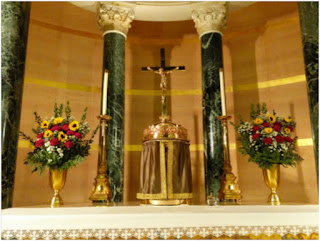St. Francis: Lover Of God, Lover Of Nature
This statue of St. Francis made of stone can be found in the lawn between the Nold Education building, the Benedict XVI dormitory and the Beran Library. St. Francis is depicted in deep thinking as he contemplates the Lord through creation. He is carrying a bird with his hands and making the shape of a triangle with his fingers. We find another bird on his right shoulder. His eyes are not seeing the creating world but rather they seem to be contemplating something out of this world. He is wearing the traditional Franciscan habit with the cord and its three knots. What does all this mean?
Francis, an Italian monk
from Assisi lived in the 12th century. His life here on earth was
extraordinary in many ways: from living a life of extreme poverty to receiving
the stigmata (marks of the wounds of Christ) in his body. He is well known for
listening Jesus’ voice telling him: “Francis,
Francis, go and repair My house which, as you can see, is falling into ruins.” He also founded the Franciscan Order, which
spread out quickly to different parts of the world.
The location of the statue is appropriately out in a garden, right where nature is. St. Francis’ love of nature is recognizable in his own character and approach to theology. He wrote the famous “Canticle of the Sun” in which he praises God and gives Him thanks for creation, referring to the fire as his brother, and the water as his sister. He understood man’s responsibility for creation is linked to an attitude of respect and care of every single created being around us. God desired everything in creation, and St. Francis respected that.
The artwork carries several symbols of St. Francis’ life and spirituality. The two birds come from a legend in which the birds never flew away from St. Francis while he was singing and preaching to them. One bird is on his right shoulder. The right side in the Bible means justice or goodness. We learn that when God created the world, “God said it was good (Gen. 1).” The other bird gives us the message of safety. The hands of St. Francis give this sense of safety, but his hands also form a triangle, which alludes to the Holy Trinity. Why? Creation belongs to the triune God who entrusted man with its care. “The Lord God placed man in the Garden of Eden to work it and take care of it (Gen 2:15).
The three knots in St. Francis’ cincture (rope belt) signify the three vows of chastity, poverty, and obedience that every religious must profess. Every religious conform their life to Christ through these “Evangelical Counsels”. The gaze of St. Francis is a gaze of mercy. He is no longer seeing with his biological eyes, but with eyes of contemplation. He is in the world but understands he is not of it. St. Francis was able to know God through creation, because the beauty of creation reflects the infinite beauty of the Creator: His goodness and power.




Comments
Post a Comment